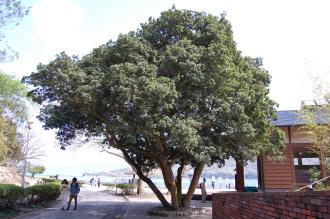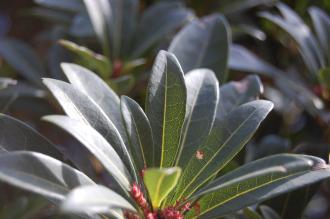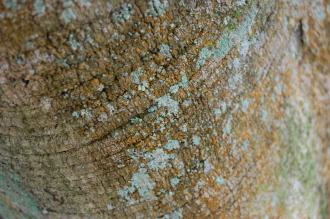
Myrica rubra Bark Leaf (11/04/2015, Okunoshima Island, Japan)
Position: Full sun to light shade
Flowering period: Spring
Soil: Moist, well drained, neutral to acid
Eventual Height: 15m
Eventual Spread: 15m
Hardiness: 9b, 10a, 10b, 11
Family: Myricaceae
Myrica rubra is an evergreen tree with a domed habit. Its leathery dark green leaves are narrow elliptic with entire margins, up to 14cm long and 4cm broad. Its trunk may achieve a diameter of up to 60cm. Its gray bark is smooth. This tree is dioecious with separate male and female plants. Its red to dark purple fruit are spherical, knobbly, up to 1.5cm across. Its roots will fix nitrogen in soil.

Myrica rubra Bark Leaf (11/04/2015, Okunoshima Island, Japan)
Myrica rubra, commonly known as Chinese Bayberry, Japanese Bayberry, Yumberry, Waxberry, Chinese Strawberry or Yangmei, is native to south China. This tree has naturalised in a number of countries including, Japan, Taiwan, Korea, Philippines and Nepal. In its native habitat it grows in mixed forests on mountain slopes at an altitude between 100m – 1500m.
The etymological root of the binomial name Myrica is derived from the Ancient Greek name for another shrub, probably the tamarisk. Rubra is from the Latin meaning ‘red’.
The landscape architect may find Myrica rubra useful as an attractive parkland tree. It is also suitable for use as street tree due to its tolerance of poor soils. Care should be taken when locating this tree due to its fruit dropping a causing a mess.

Myrica rubra Bark (11/04/2015, Okunoshima Island, Japan)
Ecologically, Myrica rubra fruit are attrative to birds and mammals (including humans).
Myrica rubra prefers moist, fertile, well-drained soils. It prefers an acid to neutral pH of soil. It will tolerate poor soils.
Myrica rubra requires little maintenance.

Landscape Architecture

